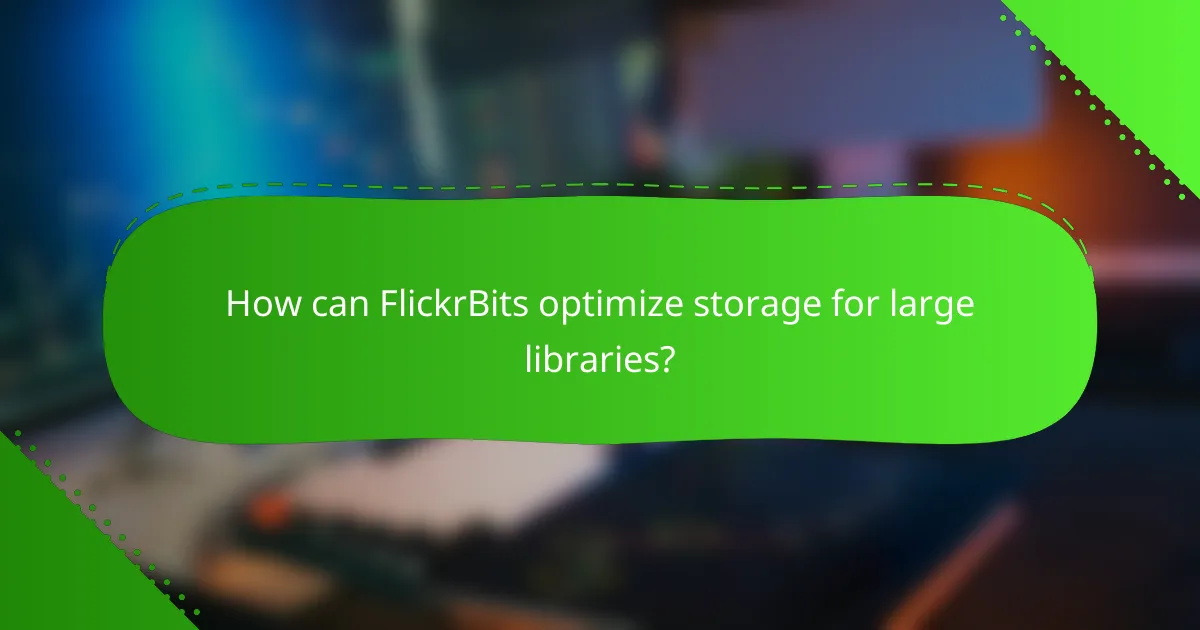FlickrBits is designed to optimize storage for large libraries, utilizing advanced file compression and automated organization to enhance efficiency. With features like bulk uploads and customizable storage plans, it caters specifically to photographers and creatives managing extensive image collections, ensuring improved accessibility and reduced storage costs.

How can FlickrBits optimize storage for large libraries?
FlickrBits optimizes storage for large libraries by employing advanced file compression, automated organization, and scalable cloud integration. These features help manage extensive photo collections efficiently, reducing storage costs and improving accessibility.
Efficient file compression techniques
FlickrBits utilizes state-of-the-art compression algorithms to minimize file sizes without significantly sacrificing quality. This can lead to storage savings of up to 50% compared to uncompressed formats, making it ideal for users with large libraries.
When selecting compression settings, users should consider the balance between quality and size. Lossless compression is suitable for archival purposes, while lossy options can be used for everyday sharing where slight quality loss is acceptable.
Automated organization features
FlickrBits offers automated tagging and categorization tools that streamline the organization of large libraries. By using AI-driven algorithms, it can analyze images and assign relevant tags, making it easier to locate specific photos quickly.
Users can set up rules for automatic sorting based on metadata such as date, location, or subject matter. This reduces the manual effort required to maintain an organized library and enhances the overall user experience.
Cloud integration for scalability
FlickrBits integrates seamlessly with cloud storage solutions, allowing users to scale their storage needs as their libraries grow. This flexibility means that users can start with minimal storage and expand as necessary without significant upfront investment.
Choosing a cloud provider that offers competitive pricing and reliable performance is crucial. Users should evaluate options based on factors like data transfer speeds, security measures, and ease of access to ensure they meet their specific needs.

What are the key features of FlickrBits for efficiency?
FlickrBits offers several key features designed to enhance efficiency for users managing large libraries of images. These include bulk upload capabilities, advanced search functionality, and customizable storage plans that cater to various needs.
Bulk upload capabilities
FlickrBits allows users to upload multiple images simultaneously, significantly reducing the time spent on managing large libraries. This feature is particularly beneficial for photographers and businesses that need to upload hundreds or thousands of images at once.
To utilize bulk uploads effectively, users should prepare their images in organized folders and ensure they meet the platform’s file size and format requirements. This preparation can streamline the uploading process and minimize errors.
Advanced search functionality
The advanced search functionality in FlickrBits enables users to quickly locate specific images within extensive libraries. Users can filter searches by various criteria such as tags, dates, and file types, making it easier to find the right content without sifting through numerous files.
To maximize the benefits of this feature, users should consistently tag their images with relevant keywords upon upload. This practice enhances searchability and helps maintain an organized library.
Customizable storage plans
FlickrBits offers customizable storage plans that allow users to choose the amount of storage that best fits their needs. This flexibility is crucial for users with varying requirements, from casual photographers to professional studios with extensive archives.
When selecting a storage plan, consider factors such as anticipated growth in image volume and the types of images being stored. Users should also evaluate the cost-effectiveness of different plans to ensure they are getting the best value for their storage needs.

How does FlickrBits compare to other storage solutions?
FlickrBits offers unique advantages over traditional storage solutions by focusing on optimized storage for large libraries, enhancing efficiency and accessibility. Its specialized features cater to photographers and creatives who require robust management of extensive image collections.
Comparison with Google Drive
Google Drive provides a versatile cloud storage solution with a user-friendly interface, allowing easy file sharing and collaboration. However, FlickrBits excels in managing large libraries, offering tailored tools for image organization and retrieval that Google Drive lacks.
While Google Drive offers 15 GB of free storage, FlickrBits focuses on optimizing storage efficiency, which can be particularly beneficial for users with extensive photo collections. Users should consider their specific needs for image management when choosing between these options.
Comparison with Dropbox
Dropbox is known for its seamless file synchronization and sharing capabilities, making it a popular choice for general storage needs. In contrast, FlickrBits is designed specifically for photographers, providing advanced features like metadata management and bulk editing tools that enhance workflow efficiency.
Dropbox offers 2 GB of free storage, but users may find that FlickrBits’ specialized features justify its costs for those managing large photo libraries. Evaluating the importance of collaboration versus specialized image management is crucial when deciding between these platforms.
Comparison with Adobe Creative Cloud
Adobe Creative Cloud integrates various creative tools for professionals, including storage options for project files. However, FlickrBits stands out by focusing solely on image storage and optimization, making it a more efficient choice for photographers who prioritize image management over software integration.
Adobe’s plans can be costly, with storage options starting at around $10 per month for 1 TB. FlickrBits may offer a more cost-effective solution for users primarily focused on storing and organizing images, especially those with large libraries. Understanding your primary needs can help in selecting the right storage solution.

What are the pricing plans for FlickrBits?
FlickrBits offers a range of pricing plans designed to accommodate different user needs, from casual photographers to professional users with extensive libraries. The plans include a free tier with limitations and various subscription options that provide additional storage and features.
Free tier limitations
The free tier of FlickrBits allows users to store a limited number of images, typically around a few hundred, which may not suffice for those with larger collections. Users on the free plan may also face restrictions on features such as advanced editing tools and customer support.
Additionally, free tier users might encounter lower upload quality and slower processing times compared to paid subscribers. This can impact the overall experience, especially for users who prioritize high-quality image storage and management.
Monthly subscription options
FlickrBits offers several monthly subscription plans that provide increased storage capacity and enhanced features. These plans generally range from a few dollars to around ten dollars per month, depending on the storage size and additional functionalities included.
Subscribers can expect benefits such as unlimited storage, higher upload limits, and priority customer support. This flexibility allows users to choose a plan that best fits their usage patterns and budget.
Annual savings on plans
Choosing an annual subscription plan for FlickrBits can lead to significant savings compared to monthly payments. Typically, users may save around 15-20% by committing to a yearly plan, making it a cost-effective option for regular users.
Annual plans often include the same features as monthly subscriptions but at a reduced overall cost. This option is ideal for users who plan to utilize the service long-term and want to maximize their investment.

What are the integration capabilities of FlickrBits?
FlickrBits offers robust integration capabilities that enhance its functionality with various tools and platforms. These integrations allow users to streamline their workflows, connect with social media, and utilize third-party applications effectively.
API access for third-party tools
FlickrBits provides an API that enables developers to connect third-party tools seamlessly. This access allows for automation of tasks such as uploading images, managing albums, and retrieving metadata. Users can leverage this API to create custom applications tailored to their specific needs.
When using the API, consider the authentication process and rate limits to ensure smooth operation. Familiarity with RESTful principles will help in effectively utilizing the API for various integrations.
Integration with social media platforms
FlickrBits integrates with popular social media platforms, allowing users to share their photos directly from the application. This feature simplifies the process of posting images to sites like Facebook, Twitter, and Instagram, enhancing visibility and engagement.
To maximize the benefits of social media integration, users should optimize their images for each platform’s specifications. This includes adjusting dimensions and formats to ensure the best presentation across different channels.
Compatibility with editing software
FlickrBits is compatible with various photo editing software, making it easier for users to manage their images post-editing. Programs like Adobe Photoshop and Lightroom can directly connect, allowing for efficient uploads and organization of edited photos.
When choosing editing software, ensure it supports the file formats you typically use. This compatibility will streamline your workflow and reduce the need for file conversion, saving time and maintaining image quality.

What are the best practices for managing large libraries?
To effectively manage large libraries, implement systematic organization, regular backups, and efficient storage solutions. These practices help maintain accessibility, prevent data loss, and optimize performance.
Regular backups and data redundancy
Regular backups are essential for safeguarding your large library against data loss. Schedule automatic backups at least weekly, depending on how frequently your library is updated. Utilize both local and cloud storage options to create redundancy, ensuring that you have multiple copies in different locations.
Consider using incremental backups, which only save changes made since the last backup. This approach saves storage space and reduces backup time. Additionally, familiarize yourself with backup solutions that comply with relevant data protection regulations, such as GDPR if you are in Europe.
Common pitfalls include neglecting to test your backups and relying solely on one backup method. Regularly verify that your backups are complete and accessible, and maintain a checklist to ensure all critical data is included in your backup routine.
